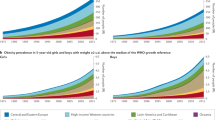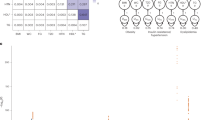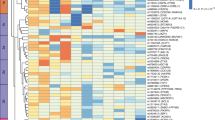Abstract
Obesity is globally prevalent and highly heritable, but its underlying genetic factors remain largely elusive. To identify genetic loci for obesity susceptibility, we examined associations between body mass index and ∼2.8 million SNPs in up to 123,865 individuals with targeted follow up of 42 SNPs in up to 125,931 additional individuals. We confirmed 14 known obesity susceptibility loci and identified 18 new loci associated with body mass index (P < 5 × 10−8), one of which includes a copy number variant near GPRC5B. Some loci (at MC4R, POMC, SH2B1 and BDNF) map near key hypothalamic regulators of energy balance, and one of these loci is near GIPR, an incretin receptor. Furthermore, genes in other newly associated loci may provide new insights into human body weight regulation.
This is a preview of subscription content, access via your institution
Access options
Subscribe to this journal
Receive 12 print issues and online access
$209.00 per year
only $17.42 per issue
Buy this article
- Purchase on SpringerLink
- Instant access to full article PDF
Prices may be subject to local taxes which are calculated during checkout





Similar content being viewed by others
Change history
12 October 2011
In the version of this supplementary file originally posted online, there was an error in the equation shown on page 36. The error has been corrected in this file as of 12 October 2011.
References
Anonymous. Clinical guidelines on the identification, evaluation, and treatment of overweight and obesity in adults–the evidence report. National Institutes of Health. Obes. Res. 6 Suppl 2, 51S–209S (1998); erratum Obes. Res. 6, 464 (1998); comment Obes. Res. 6, 461–462 (1998).
Lewis, C.E. et al. Mortality, health outcomes, and body mass index in the overweight range: a science advisory from the American Heart Association. Circulation 119, 3263–3271 (2009).
Stunkard, A.J., Foch, T.T. & Hrubec, Z. A twin study of human obesity. J. Am. Med. Assoc. 256, 51–54 (1986).
Maes, H.H., Neale, M.C. & Eaves, L.J. Genetic and environmental factors in relative body weight and human adiposity. Behav. Genet. 27, 325–351 (1997).
Taylor, A.E. et al. Comparison of the associations of body mass index and measures of central adiposity and fat mass with coronary heart disease, diabetes, and all-cause mortality: a study using data from 4 UK cohorts. Am. J. Clin. Nutr. 91, 547–556 (2010).
Frayling, T.M. et al. A common variant in the FTO gene is associated with body mass index and predisposes to childhood and adult obesity. Science 316, 889–894 (2007).
Scuteri, A. et al. Genome-wide association scan shows genetic variants in the FTO gene are associated with obesity-related traits. PLoS Genet. 3, e115 (2007).
Loos, R.J. et al. Common variants near MC4R are associated with fat mass, weight and risk of obesity. Nat. Genet. 40, 768–775 (2008).
Willer, C.J. et al. Six new loci associated with body mass index highlight a neuronal influence on body weight regulation. Nat. Genet. 41, 25–34 (2009).
Thorleifsson, G. et al. Genome-wide association yields new sequence variants at seven loci that associate with measures of obesity. Nat. Genet. 41, 18–24 (2009).
Ren, D. et al. Neuronal SH2B1 is essential for controlling energy and glucose homeostasis. J. Clin. Invest. 117, 397–406 (2007).
Huszar, D. et al. Targeted disruption of the melanocortin-4 receptor results in obesity in mice. Cell 88, 131–141 (1997).
O'Rahilly, S. & Farooqi, I.S. Human obesity as a heritable disorder of the central control of energy balance. Int. J. Obes. (Lond) 32 Suppl 7, S55–S61 (2008).
Lindgren, C.M. et al. Genome-wide association scan meta-analysis identifies three loci influencing adiposity and fat distribution. PLoS Genet. 5, e1000508 (2009).
Heard-Costa, N.L. et al. NRXN3 is a novel locus for waist circumference: a genome-wide association study from the CHARGE Consortium. PLoS Genet. 5, e1000539 (2009).
Meyre, D. et al. Genome-wide association study for early-onset and morbid adult obesity identifies three new risk loci in European populations. Nat. Genet. 41, 157–159 (2009).
Scherag, A. et al. Two new loci for body-weight regulation identified in a joint analysis of genome-wide association studies for early-onset extreme obesity in French and German study groups. PLoS Genet. 6, e1000916 (2010).
Zeggini, E. et al. Meta-analysis of genome-wide association data and large-scale replication identifies additional susceptibility loci for type 2 diabetes. Nat. Genet. 40, 638–645 (2008).
Dupuis, J. et al. New genetic loci implicated in fasting glucose homeostasis and their impact on type 2 diabetes risk. Nat. Genet. 42, 105–116 (2010).
Kathiresan, S. et al. Common variants at 30 loci contribute to polygenic dyslipidemia. Nat. Genet. 41, 56–65 (2009).
Saxena, R. et al. Genetic variation in GIPR influences the glucose and insulin responses to an oral glucose challenge. Nat. Genet. 42, 142–148 (2010).
McIntosh, C.H., Widenmaier, S. & Kim, S.J. Glucose-dependent insulinotropic polypeptide (Gastric Inhibitory Polypeptide, GIP). Vitam. Horm. 80, 409–471 (2009).
Farooqi, I.S. et al. Heterozygosity for a POMC-null mutation and increased obesity risk in humans. Diabetes 55, 2549–2553 (2006).
Farooqi, I.S. et al. Clinical spectrum of obesity and mutations in the melanocortin 4 receptor gene. N. Engl. J. Med. 348, 1085–1095 (2003).
Marsh, D.J. et al. Response of melanocortin-4 receptor-deficient mice to anorectic and orexigenic peptides. Nat. Genet. 21, 119–122 (1999).
Unger, T.J., Calderon, G.A., Bradley, L.C., Sena-Esteves, M. & Rios, M. Selective deletion of Bdnf in the ventromedial and dorsomedial hypothalamus of adult mice results in hyperphagic behavior and obesity. J. Neurosci. 27, 14265–14274 (2007).
Li, Z., Zhou, Y., Carter-Su, C., Myers, M.G. Jr. & Rui, L. SH2B1 enhances leptin signaling by both Janus kinase 2 Tyr813 phosphorylation-dependent and -independent mechanisms. Mol. Endocrinol. 21, 2270–2281 (2007).
Gray, J. et al. Hyperphagia, severe obesity, impaired cognitive function, and hyperactivity associated with functional loss of one copy of the brain-derived neurotrophic factor (BDNF) gene. Diabetes 55, 3366–3371 (2006).
Bochukova, E.G. et al. Large, rare chromosomal deletions associated with severe early-onset obesity. Nature 463, 666–670 (2010).
Coll, A.P. & Loraine Tung, Y.C. Pro-opiomelanocortin (POMC)-derived peptides and the regulation of energy homeostasis. Mol. Cell. Endocrinol. 300, 147–151 (2009).
Krude, H. et al. Obesity due to proopiomelanocortin deficiency: three new cases and treatment trials with thyroid hormone and ACTH4–10. J. Clin. Endocrinol. Metab. 88, 4633–4640 (2003).
Miyawaki, K. et al. Inhibition of gastric inhibitory polypeptide signaling prevents obesity. Nat. Med. 8, 738–742 (2002).
Segrè, A.V. et al. Common inherited variation in mitochondrial genes is not enriched for associations with type 2 diabetes or related glycemic traits. PLoS Genet. 6, e1001058 (2010).
Emilsson, V. et al. Genetics of gene expression and its effect on disease. Nature 452, 423–428 (2008).
Myers, A.J. et al. A survey of genetic human cortical gene expression. Nat. Genet. 39, 1494–1499 (2007).
Dixon, A.L. et al. A genome-wide association study of global gene expression. Nat. Genet. 39, 1202–1207 (2007).
Purcell, S.M. et al. Common polygenic variation contributes to risk of schizophrenia and bipolar disorder. Nature 460, 748–752 (2009).
Park, J.-H. Estimation of effect size distribution from genome-wide association studies and implications for future discoveries. Nat. Genet. 42, 570–575 (2010).
Young, E.H. et al. The V103I polymorphism of the MC4R gene and obesity: population based studies and meta-analysis of 29 563 individuals. Int. J. Obes. (Lond) 31, 1437–1441 (2007).
Stutzmann, F. et al. Non-synonymous polymorphisms in melanocortin-4 receptor protect against obesity: the two facets of a Janus obesity gene. Hum. Mol. Genet. 16, 1837–1844 (2007).
Yeo, G.S. et al. Mutations in the human melanocortin-4 receptor gene associated with severe familial obesity disrupts receptor function through multiple molecular mechanisms. Hum. Mol. Genet. 12, 561–574 (2003).
Hirschhorn, J.N. Genomewide association studies—illuminating biologic pathways. N. Engl. J. Med. 360, 1699–1701 (2009).
Lemmens, V.E., Oenema, A., Klepp, K.I., Henriksen, H.B. & Brug, J. A systematic review of the evidence regarding efficacy of obesity prevention interventions among adults. Obes. Rev. 9, 446–455 (2008).
Anderson, J.W., Konz, E.C., Frederich, R.C. & Wood, C.L. Long-term weight-loss maintenance: a meta-analysis of US studies. Am. J. Clin. Nutr. 74, 579–584 (2001).
Li, Y., Willer, C., Sanna, S. & Abecasis, G. Genotype imputation. Annu. Rev. Genomics Hum. Genet. 10, 387–406 (2009).
Marchini, J., Howie, B., Myers, S., McVean, G. & Donnelly, P. A new multipoint method for genome-wide association studies by imputation of genotypes. Nat. Genet. 39, 906–913 (2007).
Guan, Y. & Stephens, M. Practical issues in imputation-based association mapping. PLoS Genet. 4, e1000279 (2008).
Abecasis, G.R. & Wigginton, J.E. Handling marker-marker linkage disequilibrium: pedigree analysis with clustered markers. Am. J. Hum. Genet. 77, 754–767 (2005).
Aulchenko, Y.S., Struchalin, M.V. & van Duijn, C.M. ProbABEL package for genome-wide association analysis of imputed data. BMC Bioinformatics 11, 134 (2010).
Aulchenko, Y.S., Ripke, S., Isaacs, A. & van Duijn, C.M. GenABEL: an R library for genome-wide association analysis. Bioinformatics 23, 1294–1296 (2007).
Purcell, S. et al. PLINK: a tool set for whole-genome association and population-based linkage analyses. Am. J. Hum. Genet. 81, 559–575 (2007).
Zhong, H., Yang, X., Kaplan, L.M., Molony, C. & Schadt, E.E. Integrating pathway analysis and genetics of gene expression for genome-wide association studies. Am. J. Hum. Genet. 86, 581–591 (2010).
Acknowledgements
A full list of acknowledgments appears in the Supplementary Note.
Funding was provided by Academy of Finland (10404, 77299, 104781, 114382, 117797, 120315, 121584, 124243, 126775, 126925, 127437, 129255, 129269, 129306, 129494, 129680, 130326, 209072, 210595, 213225, 213506 and 216374); ADA Mentor-Based Postdoctoral Fellowship; Amgen; Agency for Science, Technology and Research of Singapore (A*STAR); ALF/LUA research grant in Gothenburg; Althingi (the Icelandic Parliament); AstraZeneca; Augustinus Foundation; Australian National Health and Medical Research Council (241944, 389875, 389891, 389892, 389938, 442915, 442981, 496739, 496688, 552485 and 613672); Australian Research Council (ARC grant DP0770096); Becket Foundation; Biocenter (Finland); Biomedicum Helsinki Foundation; Boston Obesity Nutrition Research Center; British Diabetes Association (1192); British Heart Foundation (97020; PG/02/128); Busselton Population Medical Research Foundation; Cambridge Institute for Medical Research; Cambridge National Institute of Health Research (NIHR) Comprehensive Biomedical Research Centre; CamStrad (UK); Cancer Research UK; Centre for Medical Systems Biology (The Netherlands); Centre for Neurogenomics and Cognitive Research (The Netherlands); Chief Scientist Office of the Scottish Government; Contrat Plan Etat Région (France); Danish Centre for Health Technology Assessment; Danish Diabetes Association; Danish Heart Foundation; Danish Pharmaceutical Association; Danish Research Council; Deutsche Forschungsgemeinschaft (DFG; HE 1446/4-1); Department of Health (UK); Diabetes UK; Diabetes and Inflammation Laboratory; Donald W. Reynolds Foundation; Dresden University of Technology Funding Grant; Emil and Vera Cornell Foundation; Erasmus Medical Center (Rotterdam); Erasmus University (Rotterdam); European Commission (DG XII; QLG1-CT-2000-01643, QLG2-CT-2002-01254, LSHC-CT-2005, LSHG-CT-2006-018947, LSHG-CT-2004-518153, LSH-2006-037593, LSHM-CT-2007-037273, HEALTH-F2-2008-ENGAGE, HEALTH-F4-2007-201413, HEALTH-F4-2007-201550, FP7/2007-2013, 205419, 212111, 245536, SOC 95201408 05F02 and WLRT-2001-01254); Federal Ministry of Education and Research (Germany) (01AK803, 01EA9401, 01GI0823, 01GI0826, 01GP0209, 01GP0259, 01GS0820, 01GS0823, 01GS0824, 01GS0825, 01GS0830, 01GS0831, 01IG07015, 01KU0903, 01ZZ9603, 01ZZ0103, 01ZZ0403 and 03ZIK012); Federal State of Mecklenburg-West Pomerania; European Social Fund; Eve Appeal; Finnish Diabetes Research Foundation; Finnish Foundation for Cardiovascular Research; Finnish Foundation for Pediatric Research, Finnish Medical Society; Finska Läkaresällskapet, Päivikki and Sakari Sohlberg Foundation, Folkhälsan Research Foundation; Fond Européen pour le Développement Régional (France); Fondation LeDucq (Paris, France); Foundation for Life and Health in Finland; Foundation for Strategic Research (Sweden); Genetic Association Information Network; German Research Council (KFO-152); German National Genome Research Net 'NGFNplus' (FKZ 01GS0823); German Research Center for Environmental Health; Giorgi-Cavaglieri Foundation; GlaxoSmithKline; Göteborg Medical Society; Great Wine Estates Auctions; Gyllenberg Foundation; Health Care Centers in Vasa, Närpes and Korsholm; Healthway, Western Australia; Helmholtz Center Munich; Helsinki University Central Hospital, Hjartavernd (the Icelandic Heart Association); INSERM (France); Ib Henriksen Foundation; Interdisziplinäres Zentrum für Klinische Forschung (IZKF) (B27); Jalmari and Rauha Ahokas Foundation; Juho Vainio Foundation; Juvenile Diabetes Research Foundation International (JDRF); Karolinska Institute; Knut and Alice Wallenberg Foundation; Leenaards Foundation; Lundbeck Foundation Centre of Applied Medical Genomics for Personalized Disease Prediction, Prevention and Care (LUCAMP); Lundberg Foundation; Marie Curie Intra-European Fellowship; Medical Research Council (UK) (G0000649, G0000934, G9521010D, G0500539, G0600331 and G0601261, PrevMetSyn); Ministry of Cultural Affairs and Social Ministry of the Federal State of Mecklenburg-West Pomerania; Ministry for Health, Welfare and Sports (The Netherlands); Ministry of Education (Finland); Ministry of Education, Culture and Science (The Netherlands); Ministry of Internal Affairs and Health (Denmark); Ministry of Science, Education and Sport of the Republic of Croatia (216-1080315-0302); Ministry of Science, Research and the Arts Baden-Württemberg; Montreal Heart Institute Foundation; Municipal Health Care Center and Hospital in Jakobstad; Municipality of Rotterdam; Närpes Health Care Foundation; National Cancer Institute; National Health and Medical Research Council of Australia; National Institute for Health Research Cambridge Biomedical Research Centre; National Institute for Health Research Oxford Biomedical Research Centre; National Institute for Health Research comprehensive Biomedical Research Centre; US National Institutes of Health (263-MA-410953, AA07535, AA10248, AA014041, AA13320, AA13321, AA13326, CA047988, CA65725, CA87969, CA49449, CA67262, CA50385, DA12854, DK58845, DK46200, DK062370, DK063491, DK072193, HG002651, HL084729, HHSN268200625226C, HL71981, K23-DK080145, K99-HL094535, M01-RR00425, MH084698, N01-AG12100, NO1-AG12109, N01-HC15103, N01-HC25195, N01-HC35129, N01-HC45133, N01-HC55015, N01-HC55016, N01-HC55018, N01-HC55019, N01-HC55020, N01-N01HC-55021, N01-HC55022, N01-HC55222, N01-HC75150, N01-HC85079, N01-HC85080, N01-HG-65403, N01-HC85081, N01-HC85082, N01-HC85083, N01-HC85084, N01-HC85085, N01-HC85086, N02-HL64278, P30-DK072488, R01-AG031890, R01-DK073490, R01-DK075787, R01DK068336, R01DK075681, R01-HL59367, R01-HL086694, R01-HL087641, R01-HL087647, R01-HL087652, R01-HL087676, R01-HL087679, R01-HL087700, R01-HL088119, R01-MH59160, R01-MH59565, R01-MH59566, R01-MH59571, R01-MH59586, R01-MH59587, R01-MH59588, R01-MH60870, R01-MH60879, R01-MH61675, R01-MH63706, R01-MH67257, R01-MH79469, R01-MH79470, R01-MH81800, RL1-MH083268, UO1-CA098233, U01-DK062418, U01-GM074518, U01-HG004402, U01-HG004399, U01-HL72515, U01-HL080295, U01-HL084756, U54-RR020278, T32-HG00040, UL1-RR025005 and Z01-HG000024); National Alliance for Research on Schizophrenia and Depression (NARSAD); Netherlands Genomics Initiative/Netherlands Consortium for Healthy Aging (050-060-810); Netherlands Organisation for Scientific Research (NWO) (904-61-090, 904-61-193, 480-04-004, 400-05-717, SPI 56-464-1419, 175.010.2005.011 and 911-03-012); Nord-Trøndelag County Council; Nordic Center of Excellence in Disease Genetics; Novo Nordisk Foundation; Norwegian Institute of Public Health; Ollqvist Foundation; Oxford NIHR Biomedical Research Centre; Organization for the Health Research and Development (10-000-1002); Paavo Nurmi Foundation; Paul Michael Donovan Charitable Foundation; Perklén Foundation; Petrus and Augusta Hedlunds Foundation; Pew Scholar for the Biomedical Sciences; Public Health and Risk Assessment, Health and Consumer Protection (2004310); Research Foundation of Copenhagen County; Research Institute for Diseases in the Elderly (014-93-015; RIDE2); Robert Dawson Evans Endowment; Royal Society (UK); Royal Swedish Academy of Science; Sahlgrenska Center for Cardiovascular and Metabolic Research (CMR, no. A305: 188); Siemens Healthcare, Erlangen, Germany; Sigrid Juselius Foundation; Signe and Ane Gyllenberg Foundation; Science Funding programme (UK); Social Insurance Institution of Finland; Söderberg's Foundation; South Tyrol Ministry of Health; South Tyrolean Sparkasse Foundation; State of Bavaria; Stockholm County Council (560183); Susan G. Komen Breast Cancer Foundation; Swedish Cancer Society; Swedish Cultural Foundation in Finland; Swedish Foundation for Strategic Research; Swedish Heart-Lung Foundation; Swedish Medical Research Council (8691, K2007-66X-20270-01-3, K2010-54X-09894-19-3, K2010-54X-09894-19-3 and 2006-3832); Swedish Research Council; Swedish Society of Medicine; Swiss National Science Foundation (33CSCO-122661, 310000-112552 and 3100AO-116323/1); Torsten and Ragnar Söderberg's Foundation; Université Henri Poincaré-Nancy 1, Région Lorraine, Communauté Urbaine du Grand Nancy; University Hospital Medical funds to Tampere; University Hospital Oulu, Finland; University of Oulu, Finland (75617); Västra Götaland Foundation; Walter E. Nichols, M.D., and Eleanor Nichols endowments; Wellcome Trust (068545, 072960, 075491, 076113, 077016, 079557, 079895, 081682, 083270, 085301 and 086596); Western Australian DNA Bank; Western Australian Genetic Epidemiology Resource; and Yrjö Jahnsson Foundation.
Author information
Authors and Affiliations
Consortia
Contributions
A full list of author contributions appears in the Supplementary Note.
Corresponding authors
Ethics declarations
Competing interests
I.B. and spouse own stock in Incyte Ltd and GlaxoSmithKline. J.N.H. is a member of the Scientific Advisory Board, Correlagen, Inc. V.H. has received consultancy fees from GlaxoSmithKline, Lilly and Takeda. A.P. is employed by Amgen. K.S., V.S., G.T., U.T. and G.B.W. are employed by deCODE Genetics.
Additional information
On behalf of the MAGIC (Meta-Analyses of Glucose and Insulin-Related Traits Consortium) investigators.
Supplementary information
Supplementary Text and Figures
Supplementary Tables 1–8, Supplementary Figures 1–4 and Supplementary Note. (PDF 4893 kb)
Rights and permissions
About this article
Cite this article
Speliotes, E., Willer, C., Berndt, S. et al. Association analyses of 249,796 individuals reveal 18 new loci associated with body mass index. Nat Genet 42, 937–948 (2010). https://doi.org/10.1038/ng.686
Received:
Accepted:
Published:
Issue Date:
DOI: https://doi.org/10.1038/ng.686



